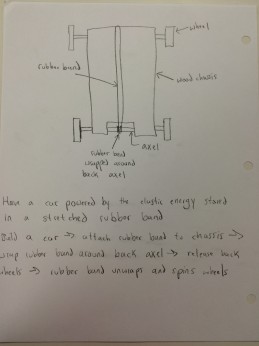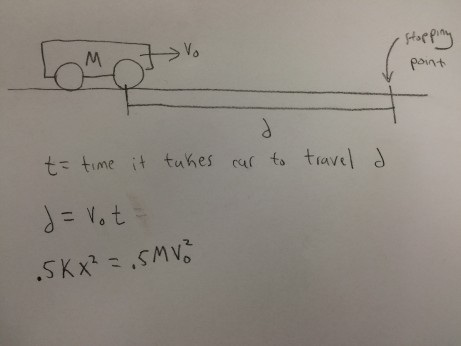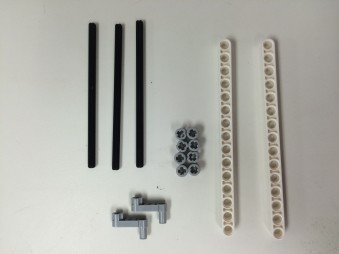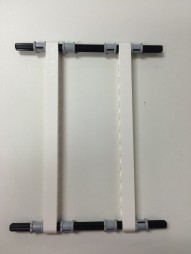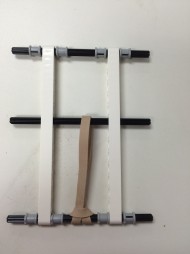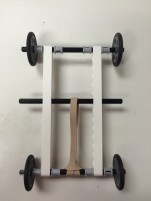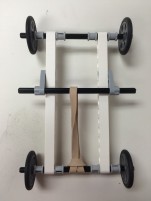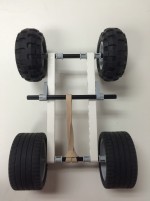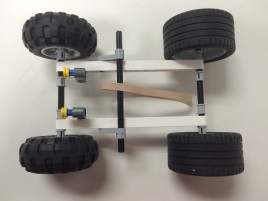Car Design: Convert Potential Energy into Kinetic Energy to Power a Car
Convert some form of potential energy into kinetic energy to power a car. Students can use gravitational energy to release their car from a slide, or students can use elastic potential energy to power their car with rubber bands, springs, or a mousetrap. Students should design a car and any other devices necessary to power their car (ie spring release or raised ramp.)
Students should also complete the math related to the energy conversion for their design. If they are using gravitational potential energy they should use mgh = .5mv^2, if using springs ma = kx, etc. Students should be able to provide reasonable estimates for how much potential energy they used up by calculating the distance the car traveled, mass of the car, and the traveling time.
Authors: Rose Solow and Orian Sneor
Final Project
Using LEGO pieces we built a car that is powered by the potential elastic energy stored in a stretched rubberband. We attached one end of the rubberband to the chassis of the car and wrapped the other end around the back axel of the car. Once the back axel was released the stretched rubberband wanted to release its internal potential elastic energy and return to its original, unstretched length. As the rubberband snapped back into place it rotated the back axel propelling the car forward.
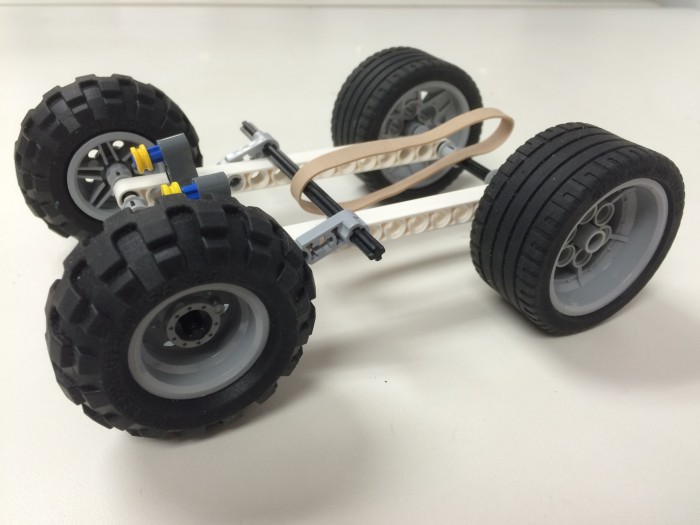
Big Idea
After this project students should be able to answer the following questions and complete the following tasks:
- What is potential energy and kinetic energy
- How can potential energy be converted into kinetic energy
- How is energy stored
- Apply physics concepts to a real-world device
- Build a device using the materials available to them
Ask
Because physics often deals with the mechanics of motion we wanted a project where the students would create something that would move. We decided to focus on the topic of energy and energy conversion since the students could play around with objects in motion. We wanted the students to build some kind of device themselves so we decided to have them design a car that they would have to power using potential energy. By having the students build a car powered by potential energy they can learn about the conversion of potential energy into kinetic energy and they are also challenged to think of different forms of potential energy to utilize in their design.
Key questions:
What form of potential energy to use?
How are we going to build the car and any other devices?
What materials are we going to use?
Brainstorm
We decided to build a car powered by the potential energy stored in a stretched rubberband. We would have the stretched rubberband wrapped around the back axel of the car so that when the rubberband was released it would rotate the back axel, the wheels would spin, and the car would go forward.
Plan
We decided to design the simplest car we could build to save on time and energy. We would build the body of the car the out of a piece of wood and have four rubber wheels attached to axels. One end of the rubberband would be permanently attached to the chassis of the car while the other would be looped around the back axel. We would wrap the rubberband by hand around the back axel and when we wanted to release the car we would let go of the axel and allow the wheels to spin freely.
Create
As we began to gather materials together to build the car we realized it would be easier to build the car out of LEGO parts so we decided not to use wood for the chassis. We gathered axels, connectors, and wheels and began to assemble the car. Our first iteration of the car had the rubberband attached to a free axel in the middle of chassis, the rubberband tied to the back axel, and four small wheels. This car did not go very far so we decided to make the middle axel more permanently attached to the chassis and not free to rotate. We permanently attached the middle axel using LEGO connecters. The car went farther now that the middle axel was not free to spin, but the front end of the car would lift up once the rubberband was released. We fixed this problem by replacing the four small wheels with four large wheels that added weight to the car preventing the front end from lifting up. Now the car successfully went forward and didn't lift up, but because the rubberband was tied to the back axel the car would reverse once the axel rewound the unstretched rubberband since it was still attached. Our final iteration of the car solved this problem by untying the rubberband to the back axel and freely wrapping it around the back axel. We also added headlights to the car to add some flare.
Materials: LEGO pieces, rubberband
Car Release
The car was a success and was able to convert the potential energy stored in the rubberband into kinetic energy. Depending on how many times you wrapped the rubberband around the back axel the car would move shorter or longer distances.
Improve
To make it easier for the students to build we suggest having them use only LEGO parts to put together their cars. LEGO pieces are super modular and easy to use, making the process of putting the car together faster and simpler. To make it more challenging you might want to specify that only elastic potential energy can be used as the energy source and exclude the use of gravitational potential energy.

